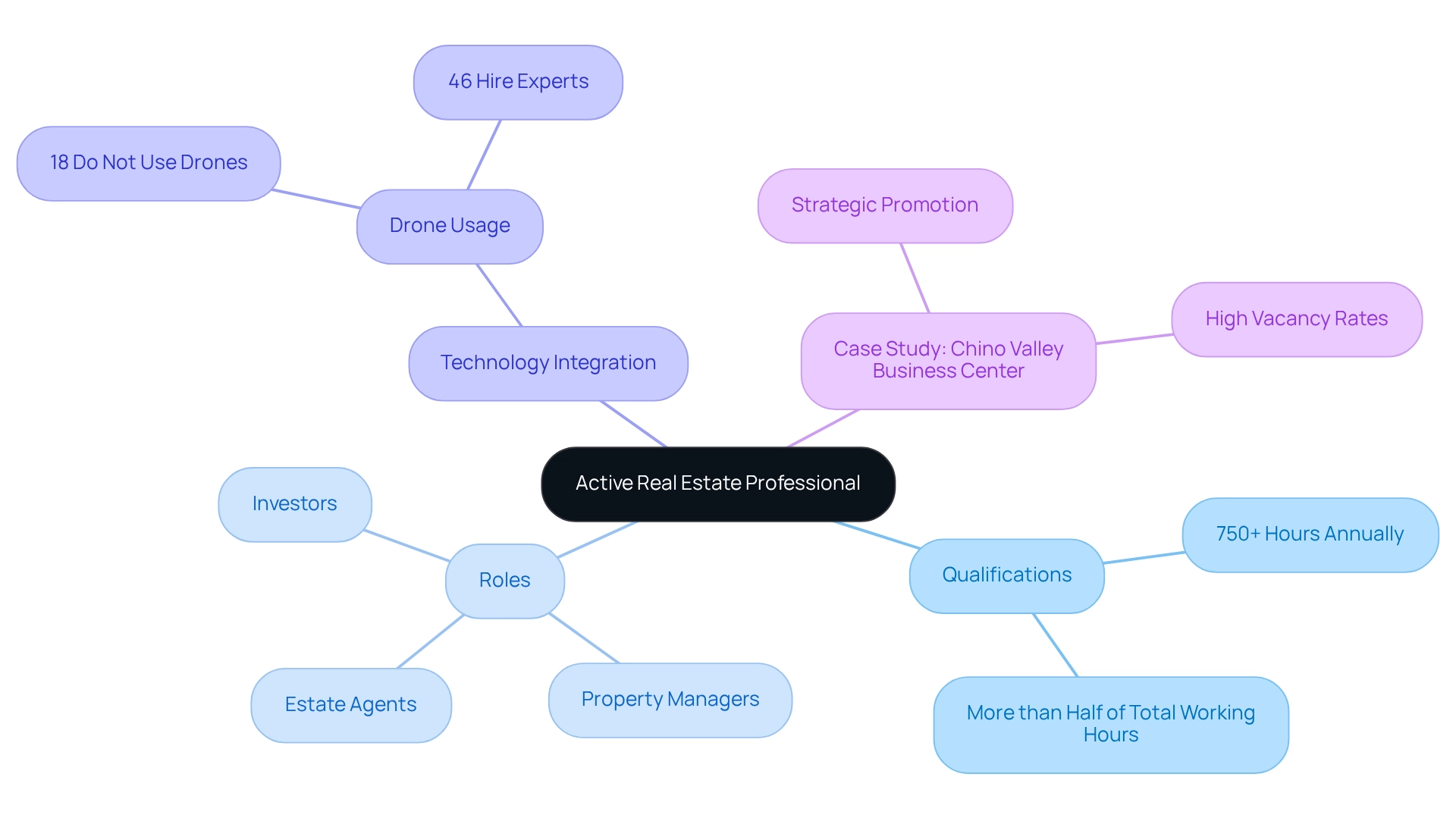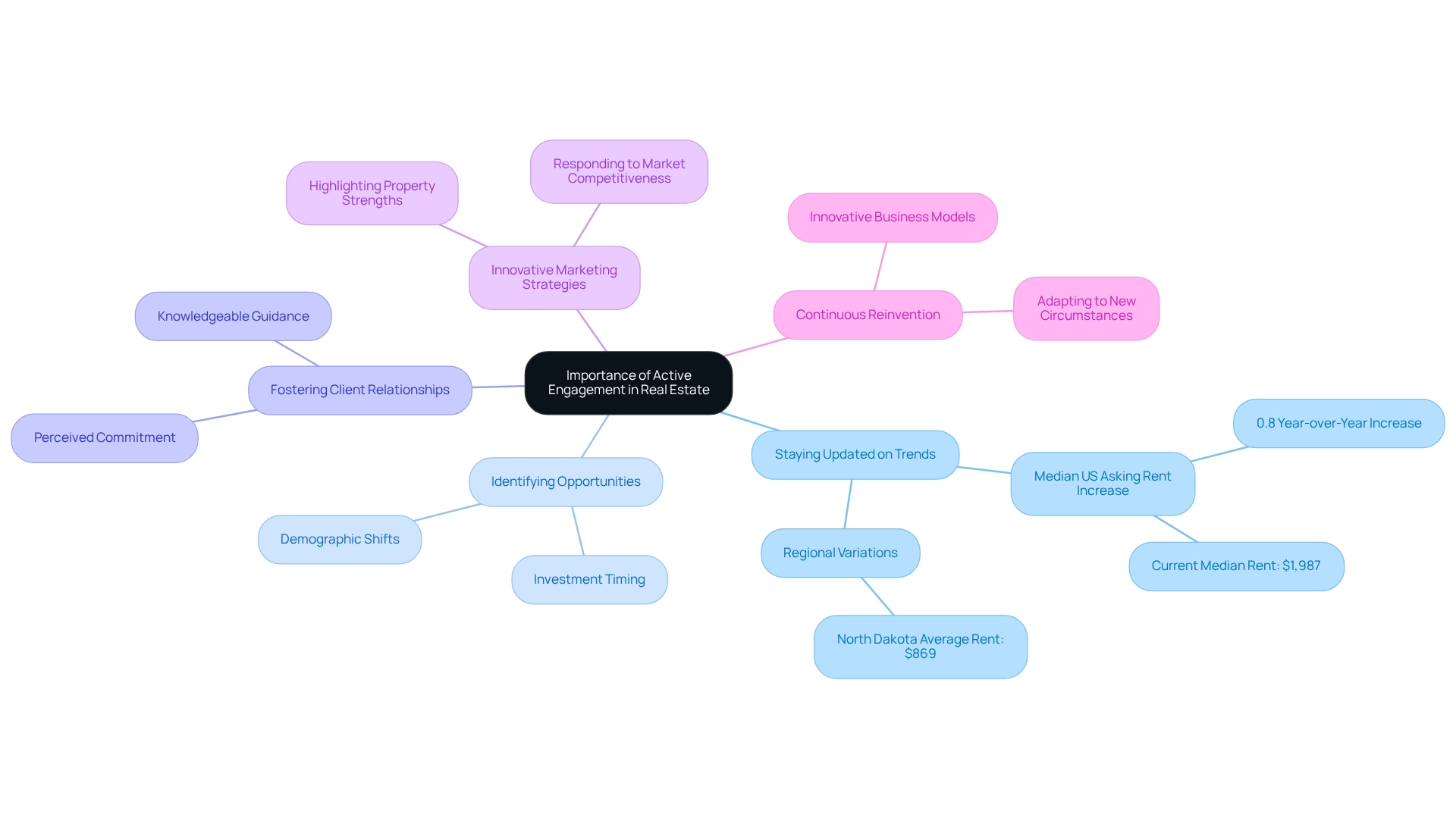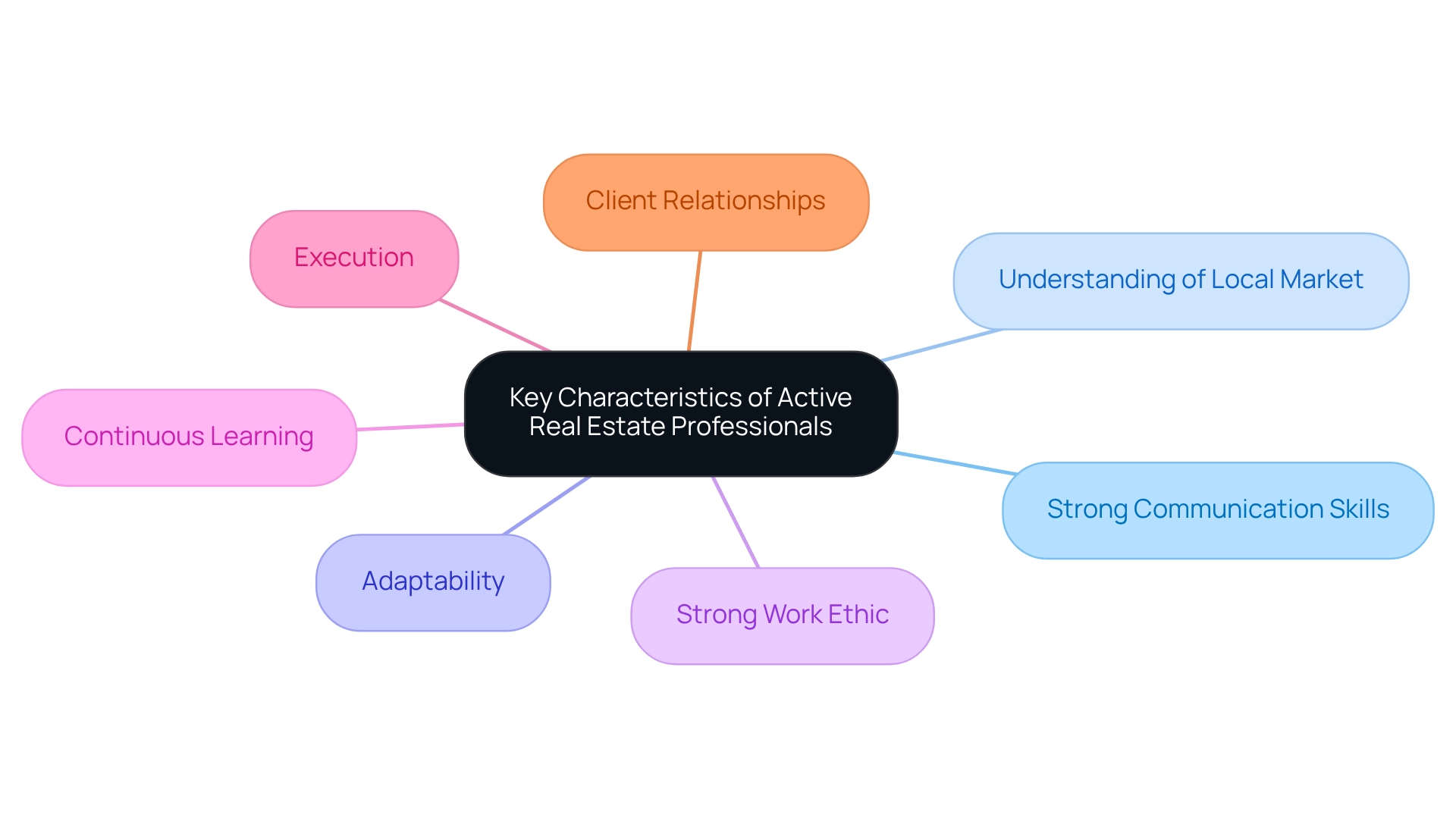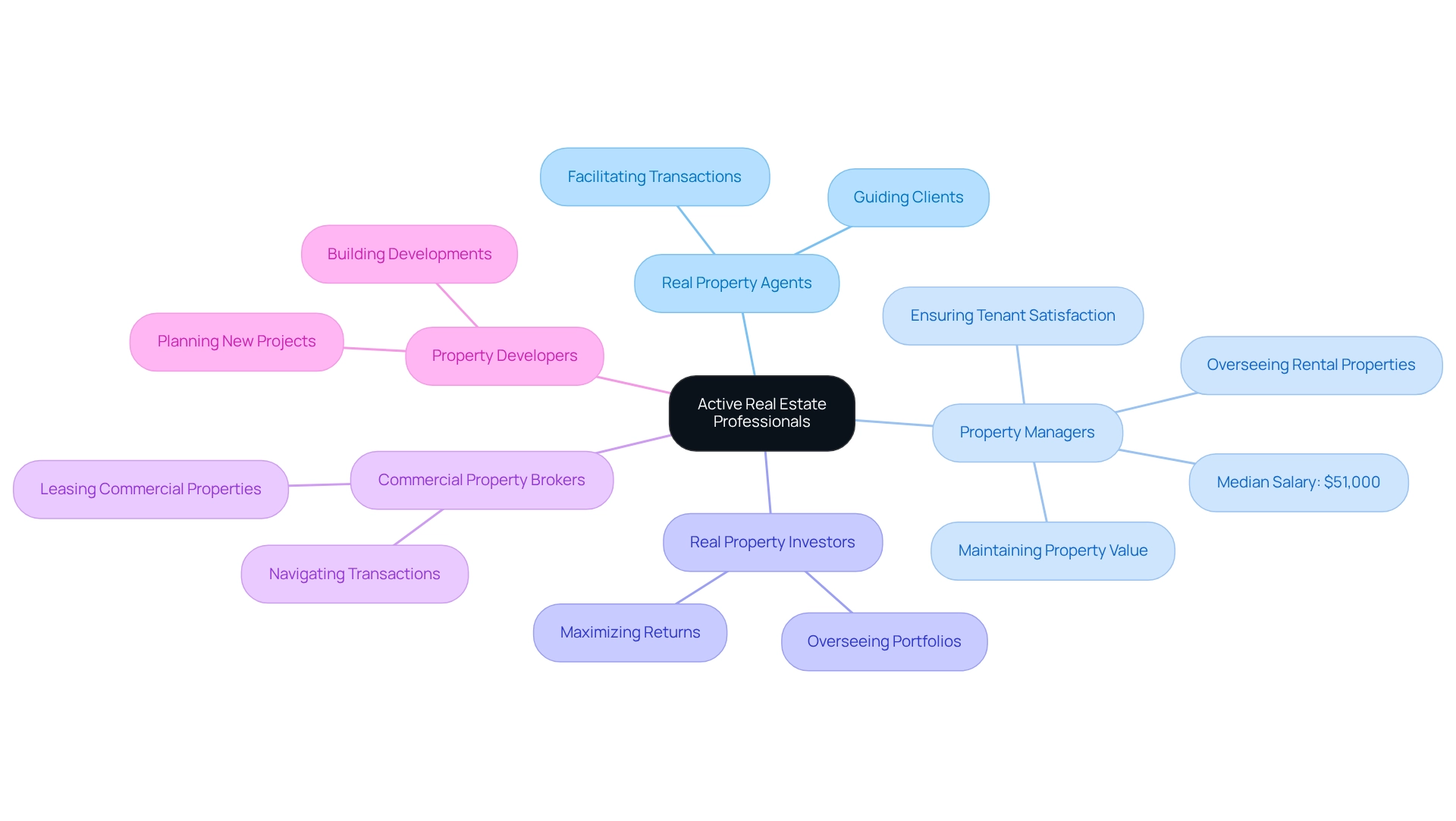Overview
Active real estate professionals are individuals who engage extensively in property activities, dedicating over 750 hours annually to qualify for tax benefits. This category encompasses roles such as:
- Estate agents
- Property managers
- Investors
Their active involvement not only enhances their expertise and client relationships but also allows them to leverage significant tax advantages. Furthermore, it enables them to adapt effectively to market trends. The implications of these factors are crucial for informed investment decisions.
Introduction
In the dynamic realm of real estate, the distinction between active and passive engagement can significantly influence a professional's success and tax benefits.
An active real estate professional dedicates substantial time and effort to the industry, engaging in activities that drive market transactions and client relationships.
With IRS guidelines stipulating over 750 hours of annual involvement for tax qualification, this role encompasses various positions, from agents to property managers and investors.
This article delves into the characteristics that define active professionals, the importance of their engagement in navigating market trends, and the historical evolution of the profession.
By exploring real-world examples and the impact of technology, readers will gain a comprehensive understanding of how active participation not only enhances professional credibility but also contributes to a thriving real estate market.
Define Active Real Estate Professional
An active real estate professional is characterized as an individual who consistently engages in property activities, dedicating a significant portion of their time to the field. According to IRS guidelines for 2025, to qualify for tax purposes, one must invest over 750 hours annually in property activities and exceed half of their total working hours in property trades or businesses. This encompasses roles such as:
- estate agents
- property managers
- investors
who are all active real estate professionals involved in managing and operating their properties. Understanding the distinction between active and passive involvement is crucial, particularly regarding tax benefits and maintaining credibility in one's profession. The IRS recognizes that activities like property development and management are vital to this classification, which can significantly impact the tax advantages available to active real estate professionals. Notably, 18% of members do not utilize drones, highlighting the diverse levels of engagement among property professionals. A practical illustration can be seen in the case of the Chino Valley Business Center, where engaged property experts addressed high vacancy rates through strategic promotion of the location. Furthermore, according to the National Association of REALTORS®, among members who incorporate drones into their property business, 46% hire an expert, showcasing the modern integration of technology in the sector. This comprehensive understanding of what constitutes an active real estate professional is essential for maximizing tax benefits and enhancing their professional reputation.

Importance of Active Engagement in Real Estate
Being an active real estate professional is essential for several compelling reasons. It allows active real estate professionals to stay updated on industry trends, which is crucial for offering clients precise and timely guidance. Active real estate professionals are typically more adept at identifying investment opportunities and recognizing demographic shifts that influence property values. Furthermore, an active real estate professional fosters stronger relationships with clients, who perceive their agents as committed and knowledgeable partners. This level of engagement not only enhances the reputation of an active real estate professional but also contributes to a more dynamic and responsive real estate environment.
For instance, as the median US asking rent increased by 0.8% year-over-year to $1,987 in March 2024, active experts who monitor such trends can better guide clients on pricing strategies and investment timing. In regions like North Dakota, where the average monthly rental expense is $869, understanding regional variations in rental rates can provide significant insights for investment decisions. Case studies indicate that in increasingly competitive markets, where buyers prioritize quality neighborhoods and affordability, individuals who actively engage with data can implement innovative marketing strategies to highlight their properties' strengths.
As property developer Akira Mori states, "In my experience, in the property business, previous success stories are usually not relevant to new circumstances. We must continually reinvent ourselves, responding to changing times with innovative new business models."
Overall, the importance of being an active real estate professional cannot be overstated, as it directly impacts the effectiveness of experts and the overall market condition, while also playing a critical role in achieving property expert status and accessing associated tax benefits.

Historical Development of Real Estate Professionals
The evolution of property experts has undergone significant transformations since the early 20th century. Initially, property transactions were informal, lacking standardized practices and regulations. The establishment of the National Association of REALTORS® in 1908 marked a pivotal moment, introducing a code of ethics that formalized the profession and established a framework for professional conduct. This advancement not only bolstered the credibility of property agents but also laid the groundwork for future regulatory improvements.
As the decades unfolded, the profession adapted to various economic and social shifts. According to the 2024 NAR Member Profile, the median gross income of REALTORS® was $55,800 in 2023, reflecting ongoing challenges and opportunities within the industry. This statistic underscores the importance of understanding market dynamics and the economic factors influencing earnings in the property sector, such as fluctuations in housing demand and investment trends.
The rise of technology and the internet has further transformed the landscape, providing property experts with unprecedented access to information and resources that enhance client interactions and streamline transactions. For example, the adoption of customer relationship management (CRM) systems and online listing platforms has revolutionized how agents engage with clients and manage their operations. Today, agents are expected to navigate a complex array of regulations and client expectations, demonstrating a level of expertise that was not required in previous decades.
Moreover, the growth of property experts over the years has been remarkable, driven by increasing demand for housing and investment opportunities. However, challenges remain; for instance, 36.1% of marketers reported that the absence of a lead generation strategy is their most significant obstacle to generating leads. The influence of the National Association of REALTORS® continues to resonate, as it advocates for its members' interests and promotes best practices within the industry. This trend illustrates a broader movement towards expertise and accountability in property, positioning active real estate professionals as essential contributors to the field.

Key Characteristics of Active Real Estate Professionals
Dynamic property experts, often regarded as active real estate professionals, embody several key traits that significantly enhance their success. Foremost among these is strong communication skills, vital for negotiating deals and fostering robust client relationships. A profound understanding of the local market is equally important for an active real estate professional, enabling them to provide valuable insights that can guide clients in their decisions. Adaptability is another essential characteristic, as the real estate environment is in constant flux, necessitating individuals to adjust and respond effectively to new challenges.
Moreover, a strong work ethic is crucial for managing multiple clients and properties simultaneously, ensuring that each client receives the attention they deserve. Successful active real estate professionals demonstrate a commitment to continuous learning by actively staying informed about industry trends, regulations, and technological advancements that can influence their practice. This dedication not only enhances their expertise but also positions them as trusted advisors in a competitive market.
Furthermore, execution plays a crucial role in property success. The ability to implement strategies effectively can differentiate top performers from their counterparts. Successful property experts respond to client needs and inquiries, treating everyone with respect and fostering connections, which is essential for long-term relationships. As Ada Louise Huxtable aptly noted, "Real property is the closest thing to the proverbial pot of gold," underscoring the potential rewards for those who excel in these key areas. Significantly, Zero Flux gathers information from over 100 varied sources, strengthening the reliability of these insights about the traits of successful property experts.

Examples of Active Real Estate Professionals
An active real estate professional encompasses a variety of roles that significantly contribute to the market. Real property agents play a crucial role in facilitating transactions, guiding clients through the buying and selling processes. Property managers are responsible for overseeing rental properties, ensuring tenant satisfaction, and maintaining property value. Their median salary in the U.S. typically ranges from $40,000 to $80,000, with a median annual income of $51,000, reflecting the importance of their role in the industry.
Real property investors actively oversee their portfolios, making strategic choices to maximize returns. Commercial property brokers focus on leasing and selling commercial properties, navigating intricate transactions that necessitate comprehensive industry knowledge. Furthermore, property developers participate in the planning and building of new projects, playing an essential role in shaping the urban environment.
Each of these active real estate professionals demonstrates their active involvement in the market, highlighting the various paths through which individuals can connect with property. Their combined efforts not only propel success for their clients but also enhance the overall well-being of the property sector. As Jesse Jones aptly remarked, "I have always enjoyed property; agricultural land, grazing land, forest land, and urban property. I have had experience with all of them. I guess I just naturally like ‘the good Earth,’ the foundation of all our wealth." This sentiment underscores the inherent worth of property as a cornerstone of economic prosperity.
For those looking to enhance their skills, resources like PropStream Academy's free course, 'Lead Strategies for The Modern Agent,' can provide valuable insights into effective lead generation strategies, further supporting the success of active real estate professionals.

Conclusion
Active engagement in the real estate industry transcends mere professional duty; it stands as a cornerstone for success and tax advantages. By dedicating over 750 hours annually to real estate activities, professionals can qualify for significant tax benefits while enhancing their market credibility. The roles of real estate agents, property managers, and investors illustrate the diverse pathways through which active participation manifests, each contributing uniquely to the vibrancy of the market.
Staying informed about market trends, understanding regional pricing dynamics, and nurturing client relationships are vital for professionals striving to excel in this competitive field. The ability to adapt and innovate, as highlighted by industry leaders, is paramount for navigating the complexities of today's real estate landscape. Historical developments and technological advancements have shaped the profession, underscoring the need for continuous learning and effective execution in achieving success.
Ultimately, active real estate professionals are essential players in fostering a dynamic and responsive market. Their commitment to engagement not only enhances their personal careers but also drives the overall health of the real estate sector. As the landscape continues to evolve, those who embrace active participation will be well-positioned to seize opportunities and deliver exceptional value to clients, ensuring a prosperous future in the industry.




